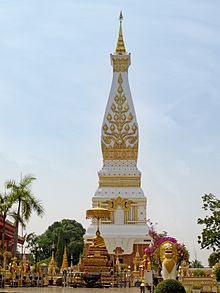This article relies largely or entirely on a single source. (July 2024) |
| Photisarath I | |||||
|---|---|---|---|---|---|
| King of Lan Xang | |||||
 That Phanom, then part of Lan Xang, enhanced by Photisarath in 1539 during a pilgrimage | |||||
| Reign | 1520–1548 | ||||
| Coronation | 1520 | ||||
| Predecessor | Visoun | ||||
| Successor | Setthathirath I | ||||
| Born | 1501 Muang Sua, Lan Xang | ||||
| Died | 1548 Xieng-Mai Nhotnakorn Palace, Vientiane, Lan Xang | ||||
| Spouse | Queen Yot Kham Tip (Lan Na) Unnamed Queen (Ayutthaya) Unnamed Queen (Khmer) Queen Kong Soi Queen Keng (Muang Phuan) Queen Pak Thuoi Luong | ||||
| Issue | Prince Setthavangso Prince Lankarnakaya Prince Tharua Prince Phya Asen Princess Keo Koumane Princess Taen Kam Lao Princess Kamagayi Princess Dharmagayi | ||||
| |||||
| Dynasty | Khun Lo | ||||
| Father | Visoun | ||||
| Religion | Therevada Buddhism | ||||
Photisarath (also spelled Phothisarath, Phothisarat, or Potisarat, Lao: ພະເຈົ້າໂພທິສະລາດ, 1501–1547), son of King Visoun of Lanxang, is considered to be the most devout of the Lao kings. He banned spirit worship and built temples upon the sites of spirit shrines. His elephant fell and crushed him while he sought to display his prowess to the diplomatic corps. His son Setthathirath returned from Chiang Mai to succeed him to the throne of Lan Xang.
Phothisarath was ruler (1520–47) of the Lao kingdom of Lan Xang whose territorial expansion embroiled Laos in the warfare that swept mainland Southeast Asia in the latter half of the 16th century. King Chairachathirat of the Ayutthaya Kingdom invaded Vientiane with a large army in 1540, captured Muang Khouk and crossed the Mekong, but succumbed to a rout at the battle of Sala Kham, the remnants fleeing for their lives and leaving enormous casualties behind. Phothisarath himself allied himself with Burma, sent out 3 campaigns against the Ayutthaya Kingdom: the first to Phitsanulok in 1535, the second one to Vieng Prangarm in 1539, and third was sent in 1548 to Vieng Prab (now Sawangaburi) where he brought back 20,000 families to settle in the Lan Xang kingdom.
In 1548, following the ascension of King Maha Chakkraphat and queen Suriyothai to the Ayutthaya Kingdom throne, Burmese king Tabinshwehti planned an attack, starting the Burmese–Siamese War. Tabinshwehti asked Phothisarath to attack Ayutthaya from the North which eventually resulted in the famous death of Suriyothai in defense of her husband.
Phothisarath was a pious Buddhist who worked to undermine animism and Brahmanic religious practices and promote Buddhism. In 1527, Phothisarath issued a decree proscribing the worship of animism as groundless superstition, and ordering their shrines to be destroyed and their altars thrown into the river.[1] He resided much of the time not in the capital at Luang Prabang but in Vientiane, which was located farther south and maintained better communications with the major states of the region. Phothisarath married a princess from Chiang Mai (now part of northern Thailand), and when his father-in-law Mueangketklao, the ruler of Lan Na or Chiang Mai, died in 1546 without a male issue, Phothisarath's own son, Setthathirath, was placed on the Chiang Mai throne. When Phothisarath died the following year, after a fatal accident while hunting wild elephants, Setthathirath succeeded him and joined together the two kingdoms—which were soon embroiled in Burmese–Siamese wars that would devastate much of the region over the next half-century.
- ^ John Holt (2009). Page 60. Spirits of the Place: Buddhism and Lao Religious Culture. University of Hawaii Press.